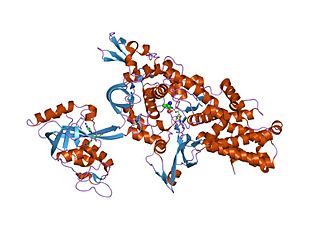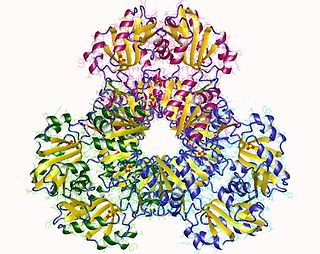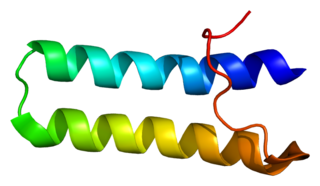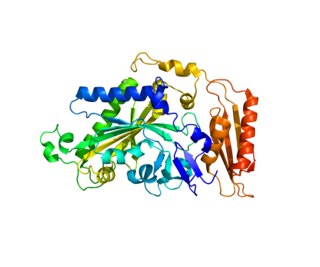Alanyl—tRNA synthetase 1 (AARS1) is an enzyme that is encoded by the AARS1 gene in humans and is a member of the aminoacyl-tRNA synthetases (ARSs) family of enzymes. [5]
Alanyl—tRNA synthetase 1 (AARS1) is an enzyme that is encoded by the AARS1 gene in humans and is a member of the aminoacyl-tRNA synthetases (ARSs) family of enzymes. [5]
Charcot-Marie-Tooth Disease type 2 (CMT2) and other peripheral neuropathies have been linked to mutations in the AARS1, GARS1, HARS1, WARS1, and YARS1 genes. [6] Mutations in these genes can encode for faulty aminoacyl-tRNA synthetases, which affects a highly conserved amino acid in the helical domain of cytoplasmic AARS1. [7] This disrupts the ability to charge tRNA with its corresponding amino acids, which leads to impaired protein synthesis. In AARS1, mutations are associated with both autosomal dominant and recessive forms of CMT2. [8]
In addition to its role in CMT2, mutations in the AARS1 gene have also been implicated in non-photosensitive trichothiodystrophy (NPS-TTD) [9] , a rare hereditary neurodevelopmental disorder. Trichothiodystrophy (TTD) is defined by sulfur-deficient brittle hair, nails, and scaly skin, [9] but presents with variable clinical features. Unlike the photosensitive form of TTD (PS-TTD), which exhibits features of progressive neuropathy and accelerated aging, NPS-TTD is not associated with premature aging. [9]
Research has identified AARS1, along with methionyl-tRNA synthetase 1 as genes in which variants can contribute to the development NPS-TTD. [9] These variants lead to the instability of the respective enzymes which they encode, affecting the rate of tRNA charging, [9] which is the first step in protein translation.

Charcot–Marie–Tooth disease (CMT) is a hereditary motor and sensory neuropathy of the peripheral nervous system characterized by progressive loss of muscle tissue and touch sensation across various parts of the body. This disease is the most commonly inherited neurological disorder, affecting about one in 2,500 people. It is named after those who classically described it: the Frenchman Jean-Martin Charcot (1825–1893), his pupil Pierre Marie (1853–1940), and the Briton Howard Henry Tooth (1856–1925).

An aminoacyl-tRNA synthetase, also called tRNA-ligase, is an enzyme that attaches the appropriate amino acid onto its corresponding tRNA. It does so by catalyzing the transesterification of a specific cognate amino acid or its precursor to one of all its compatible cognate tRNAs to form an aminoacyl-tRNA. In humans, the 20 different types of aa-tRNA are made by the 20 different aminoacyl-tRNA synthetases, one for each amino acid of the genetic code.

Myelin protein zero is a single membrane glycoprotein which in humans is encoded by the MPZ gene. P0 is a major structural component of the myelin sheath in the peripheral nervous system (PNS). Myelin protein zero is expressed by Schwann cells and accounts for over 50% of all proteins in the peripheral nervous system, making it the most common protein expressed in the PNS. Mutations in myelin protein zero can cause myelin deficiency and are associated with neuropathies like Charcot–Marie–Tooth disease and Dejerine–Sottas disease.

Ribose-phosphate diphosphokinase is an enzyme that converts ribose 5-phosphate into phosphoribosyl pyrophosphate (PRPP). It is classified under EC 2.7.6.1.

Glycine—tRNA ligase also known as glycyl–tRNA synthetase is an enzyme that in humans is encoded by the GARS1 gene.

Tyrosyl-tRNA synthetase, cytoplasmic, also known as Tyrosine-tRNA ligase, is an enzyme that in humans is encoded by the YARS gene.

Bifunctional aminoacyl-tRNA synthetase is an enzyme that in humans is encoded by the EPRS gene.

Ganglioside-induced differentiation-associated protein 1 is a type of protein that in humans is encoded by the GDAP1 gene.

Histidyl-tRNA synthetase (HARS) also known as histidine-tRNA ligase, is an enzyme which in humans is encoded by the HARS gene.

Leucyl-tRNA synthetase, cytoplasmic is an enzyme that in humans is encoded by the LARS gene.

Periaxin is a protein that in humans is encoded by the PRX gene.

Threonyl-tRNA synthetase, cytoplasmic is an enzyme that in humans is encoded by the TARS gene.

Myotubularin-related protein 2 also known as phosphatidylinositol-3,5-bisphosphate 3-phosphatase or phosphatidylinositol-3-phosphate phosphatase is a protein that in humans is encoded by the MTMR2 gene.

Isoleucyl-tRNA synthetase, cytoplasmic is an enzyme that in humans is encoded by the IARS1 gene.

SARS and cytoplasmic seryl-tRNA synthetase are a human gene and its encoded enzyme product, respectively. SARS belongs to the class II amino-acyl tRNA family and is found in all humans; its encoded enzyme, seryl-tRNA synthetase, is involved in protein translation and is related to several bacterial and yeast counterparts.

Tryptophanyl-tRNA synthetase, mitochondrial is an enzyme that in humans is encoded by the WARS2 gene.

FYVE, RhoGEF and PH domain-containing protein 4 is a protein encoded in humans by the FGD4 gene.

Phenylalanyl-tRNA synthetase, mitochondrial (FARS2) is an enzyme that in humans is encoded by the FARS2 gene. This protein encoded by FARS2 localizes to the mitochondrion and plays a role in mitochondrial protein translation. Mutations in this gene have been associated with combined oxidative phosphorylation deficiency 14, also known as Alpers encephalopathy, as well as spastic paraplegia 77 and infantile-onset epilepsy and cytochrome c oxidase deficiency.

Alanyl—tRNA synthetase, mitochondrial, also known as alanine—tRNA ligase (AlaRS) or alanyl—tRNA synthetase 2 (AARS2), is an enzyme that in humans is encoded by the AARS2 gene.
Xiang-Lei Yang (杨湘磊) is a Chinese-born American molecular biologist. She is a professor at The Scripps Research Institute, located in La Jolla, California. Her work has contributed to the establishment of physiological importance of aminoacyl-tRNA synthetases beyond their classical role in supporting mRNA translation and their disordered processes that contribute to disease. She founded the Translation Machinery in Health and Disease Gordon Research Conference, an ongoing biannual international conference since 2015. She helped co-found aTyr Pharma, a Nasdaq-listed biotechnology company.